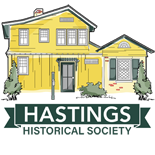Part III: A Hero’s Welcome
The Battle of New Orleans, April 25-May 1, 1862 (click on any photograph for more information)
Farragut’s victories at New Orleans in 1862 and Mobile Bay in 1864 made him a national hero. He returned to New York in December of 1864 only to find himself caught up in two weeks of banquets, luncheons, parades, and interminable speeches by New York City dignitaries.
On a snowy Saturday in January (the exact date is uncertain), a little after 4PM, Farragut’s train finally pulled into Hastings. An 1865 biography of Farragut written by P.C. Headley speaks of the admiral and his wife Virginia alighting calmly at the Hastings train station to a grand reception. But William McConnell, William Ward Tompkins, and others who were there at the time remembered things a bit differently. According to them, the Farraguts wanted to avoid the kind of welcome they had had in New York City. Upon seeing the crowds waiting for them on the platform, the couple remained on the train. They had it stopped a little further down the track and got out, determined to walk back home from there.
But Hastings residents have always been clever and resourceful. They caught up with the Farraguts at Broadway, where the admiral cheerfully agreed to return to the train station for a proper welcome. In those days the plaza in front of the station (approximately where the station parking lot is today) was called Union Square. Here the villagers had erected a triumphal arch made of evergreen branches and decorated with a huge American flag. Banners hanging from the station and from nearby buildings displayed the names of the cities where Farragut had fought his famous battles: “St. Phillip,” “Jackson,” “Gaines,” “Morgan,” “New Orleans,” and “Mobile.” At the top of the arch was the inscription “Welcome to Admiral Farragut.” (Fifty years later, George Archard still remembered being tickled at the way the sign painter had signed his name. The signature was so prominent that the inscription seemed to read “Welcome to Admiral Farragut – Phillips.”)
Beneath this arch the ceremonies began, with Farragut shaking the hands of the welcoming committee of prominent citizens, including William Few Chrystie (who became the first president of the village in 1879) and Edmund S. Mills (our second president).
The original Hastings train station ca. 1900. This station was slightly to the south of the spot where the current station now stands.
The crowd then followed the VIPs to the First Reformed Church for the official reception. It had been snowing heavily all day, and Farragut and his wife were driven up to the church in sleighs. As they rode up Spring Street and approached Warburton Avenue, they passed under another evergreen arch. Directly in front of them, on the gate to what is now the V.F.W. property, was another sign reading “Honor to the Brave,” with the initial ‘F’ above it, surrounded by a pine garland.
At the church entrance, the Farraguts walked under a canopy scattered with roses (presumably made of paper or silk) and flags. Two ladies offered the Farraguts bouquets as a band struck up “See, the Conquering Hero Comes.” More flags decorated the interior of the church, and over the pulpit was an inscription in pine branches that read “May God Bless and Preserve You.” The church was filled to capacity. People had come from Irvington, Tarrytown, and even as far away as Peekskill to see the hero of Mobile Bay. At the pulpit, Mr. Mills, an elder of the church, welcomed the admiral on behalf of the entire village. Headley’s 1865 biography gives Farragut’s reply:
“My friends and fellow citizens, it gives me great pleasure to meet you all once more at your happy home. When, nearly four years ago, I came to this village, unknown and without means, a voluntary refugee from my country… I was received with open arms, and with a warmth of friendship and a sympathy of patriotic and social intercourse that have ripened into attachments and associations which can never be effaced wherever I may be or whatever may be my future lot. Here also when absent on distant duty in a service dear to my heart, my family have found a quiet and agreeable retreat where the hand of friendship and the kindest attentions were ever extended to me. … I have been given many receptions by people throughout the country but none of them do I appreciate so highly as your warm greeting to me here in the village which is my home.”
Admiral Farragut then shook the hand of every person present. This apparently took several hours as the line moved up one aisle and back down the other. At the end of the day, the sleighs delivered the Farraguts to their dwelling on Washington Avenue.
Headley described the day, no doubt correctly, as “a scene that will be long and gratefully remembered by the inhabitants of Hastings-on-Hudson. They will dwell now and in aftertimes upon the coming of Admiral and Mrs. Farragut as among thier most cherished New Year’s gifts.”
The interior of the First Reformed Church in 1900, their 50th anniversary year.












